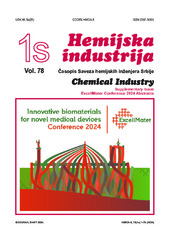| dc.description.abstract | INTRODUCTION: Following orthopedic surgery, bacterial infection may lead to significant complications related to
inflammation in the peri-implant region, including the potential for implant loosening. To address this concern, the
surface of metallic implants was modified through the application of bioactive and antibacterial coatings, aiming to
mitigate these issues.
EXPERIMENTAL: HAP/PVA/CS/Gent coatings was single-step electrophoretically deposited from four-component
aqueous suspension containing 1 wt.% hydroxyapatite powder (HAP, particles < 200 nm particle size, Sigma-Aldrich),
0.1 wt.% poly(vinyl alcohol) (PVA, medium molecular weight 89 to 98 kDa, 99 % hydrolysed, Sigma-Aldrich), 0.05 wt%
chitosan powder (CS, medium molecular weight, 190 to 310kDa with 75 to 85 % deacetylation degree, Sigma-Aldrich), and
aqueous gentamicin sulfate solution (Gent, concentration 50 mg/ml, Sigma-Aldrich) on titanium plates (Sigma-Aldrich).
Antibacterial activity of HAP/PVA/CS/Gent coating was evaluated against Staphylococcus aureus TL (culture collection-
FTM, University of Belgrade, Serbia) and Escherichia coli ATCC 25922, while kinetics of antibacterial activity was monitored
according to our previously published data [1]. In vitro cytotoxicity assay was performed towards two fibroblast cell lines
of different origin-mouse origin cell line (L929 (ATCC CRL-6364)) and human lung origin cell line (MRC-5 (ATCC CCL-171)) [2].
To evaluate the statistical significance of the biological assay results (antibacterial activity, cytotoxicity and ALP activity),
one-way analysis of variance (ANOVA) followed by a multiple comparisons posthoc test was used.
RESULTS AND DISCUSSION: HAP/PVA/CS/Gent coating exhibited strong antibacterial effect against both S. aureus
and E. coli, especially pronounced against S. aureus, causing bactericidal effect. Cytotoxic effect of HAP/PVA/CS/Gent
coating was not pronounced in investigated MRC-5 and L929 cell lines. MRC-5 fibroblast cells in contact with
HAP/PVA/CS/Gent doubled alkaline phosphatase levels compared to their contact with the control samples
(HAP/PVA/CS), indicating good osteogenic properties.
CONCLUSIONS: Electrophoretically deposited HAP/PVA/CS/Gent bioceramic coatings on titanium, demonstrated
significant potential as implants in orthopedic practice, functioning as drug carriers. Not only do they possess
antibacterial properties, but they also exhibit no adverse effects on living tissue. | sr |

